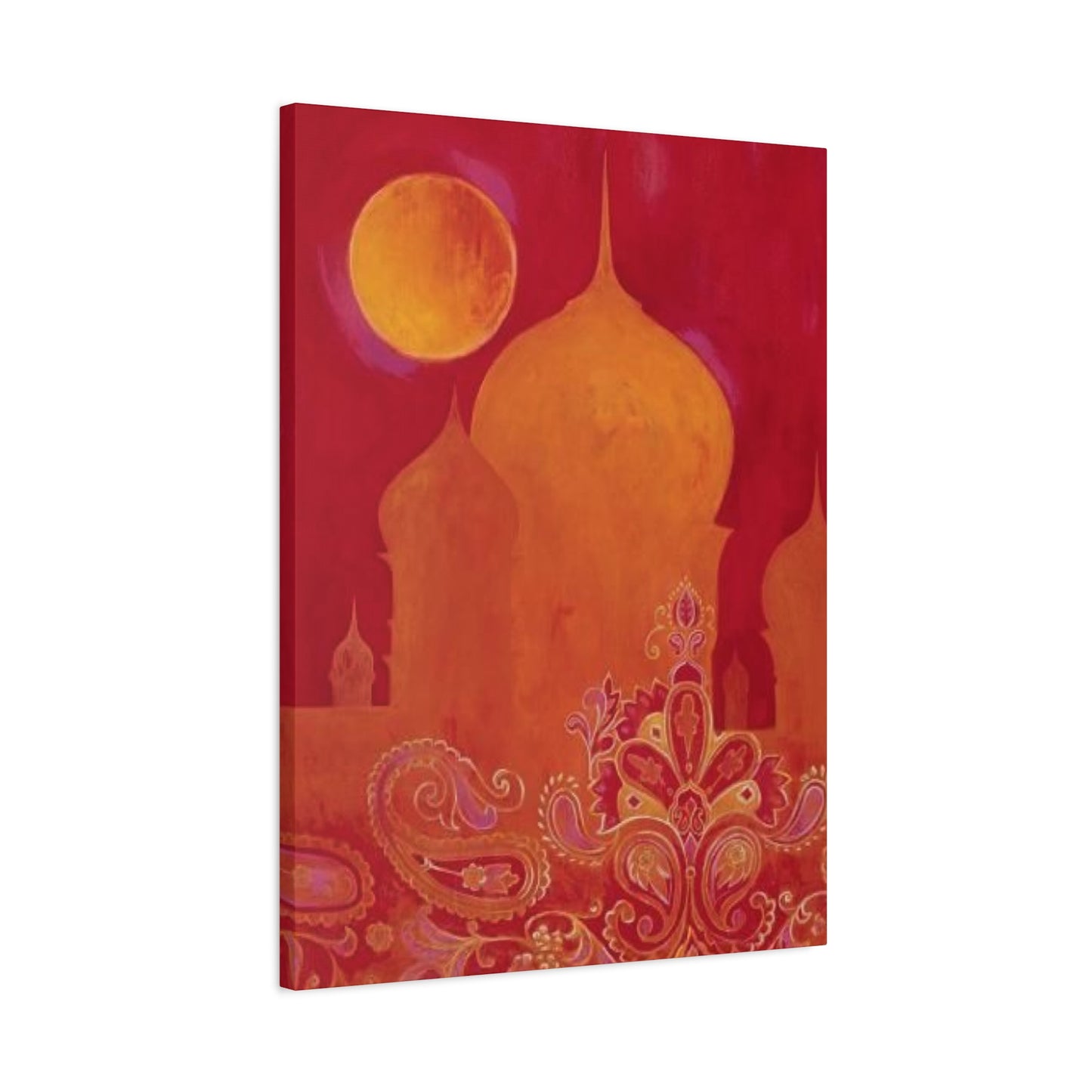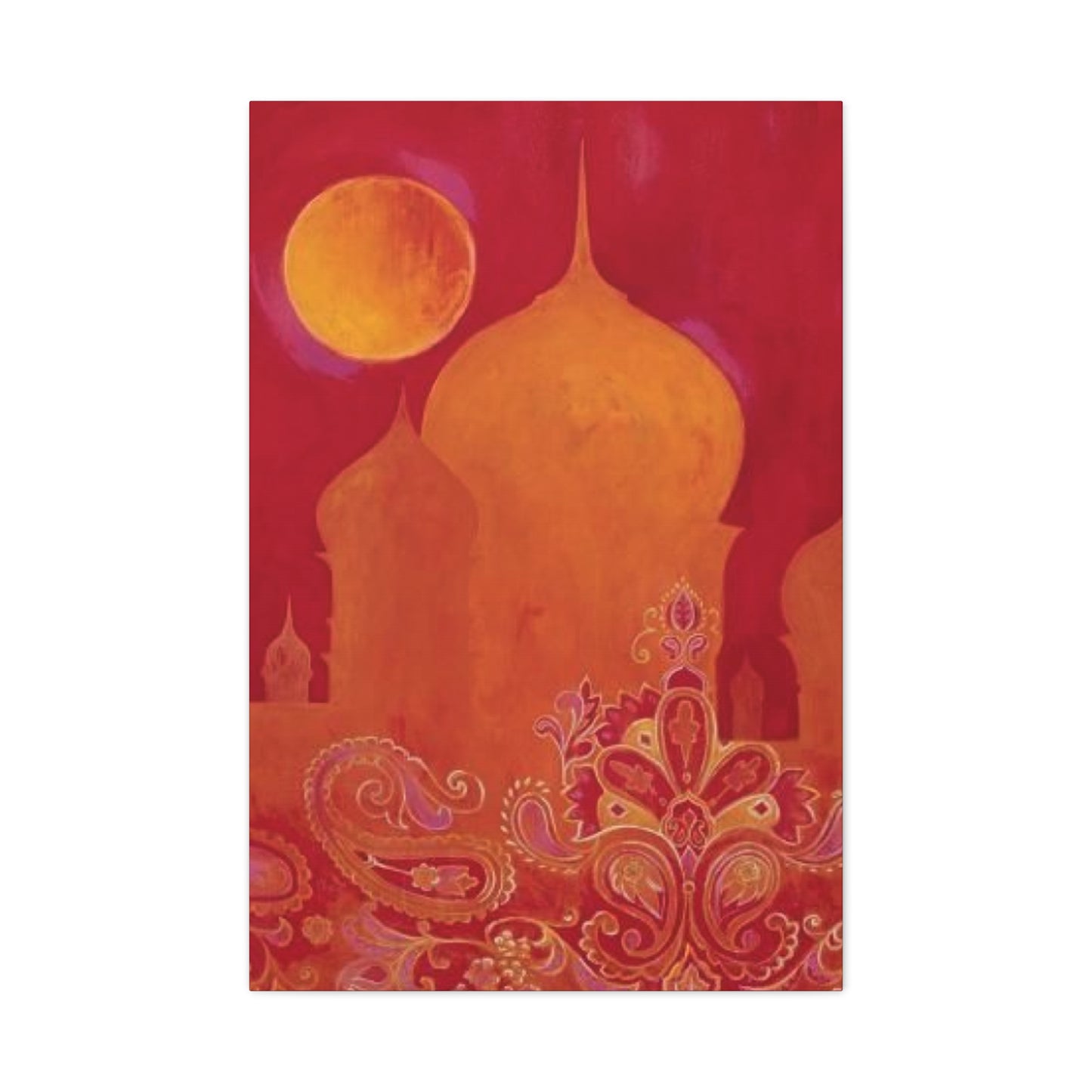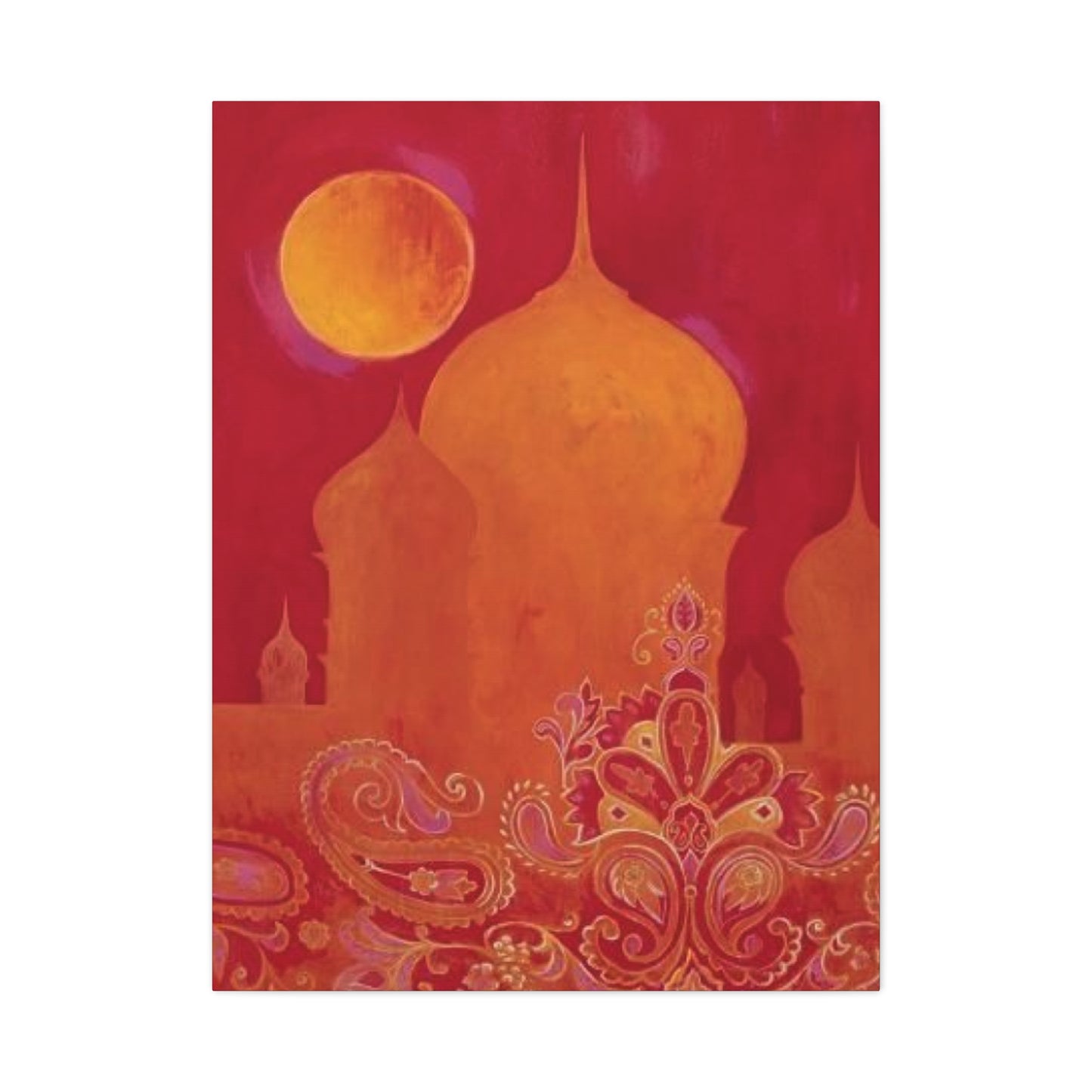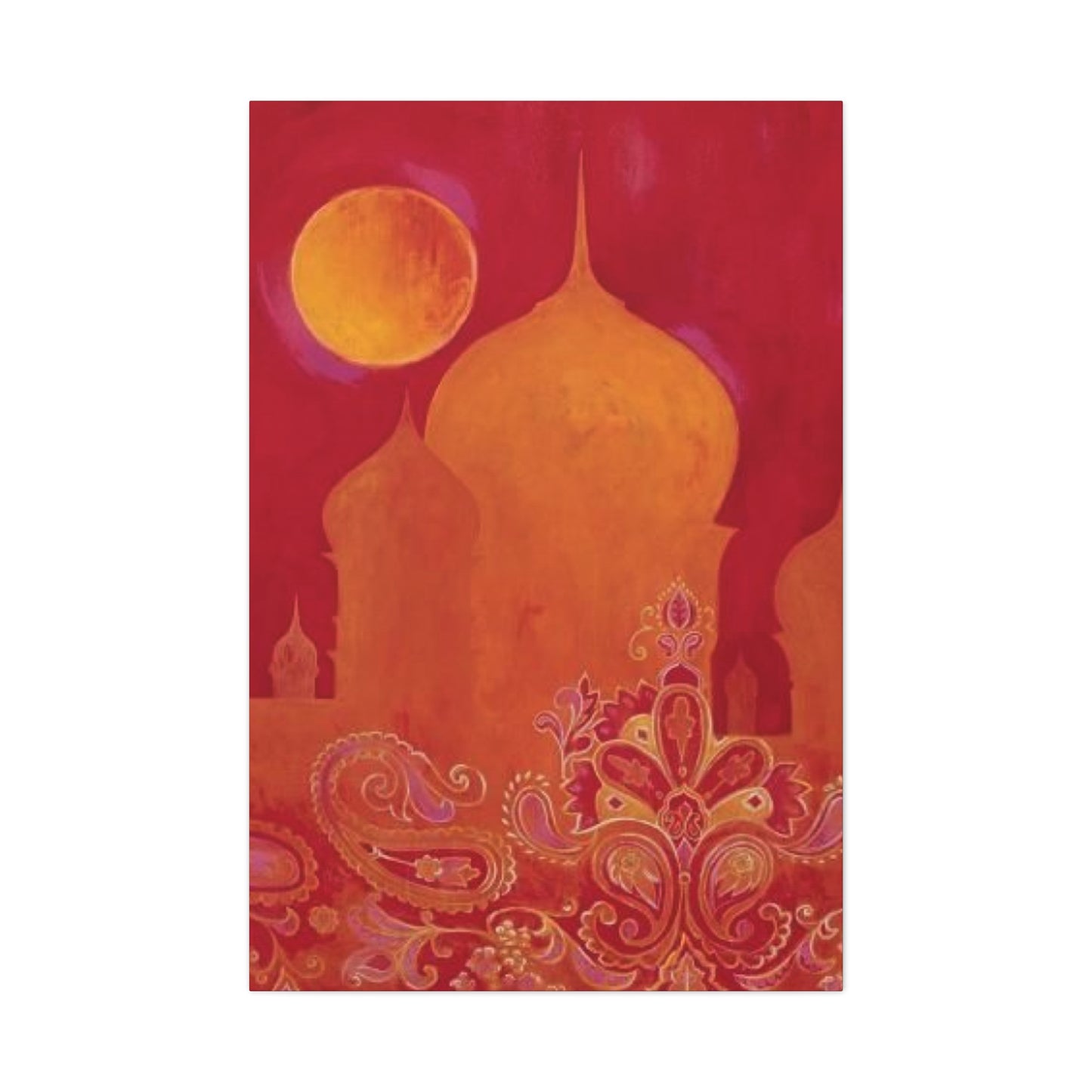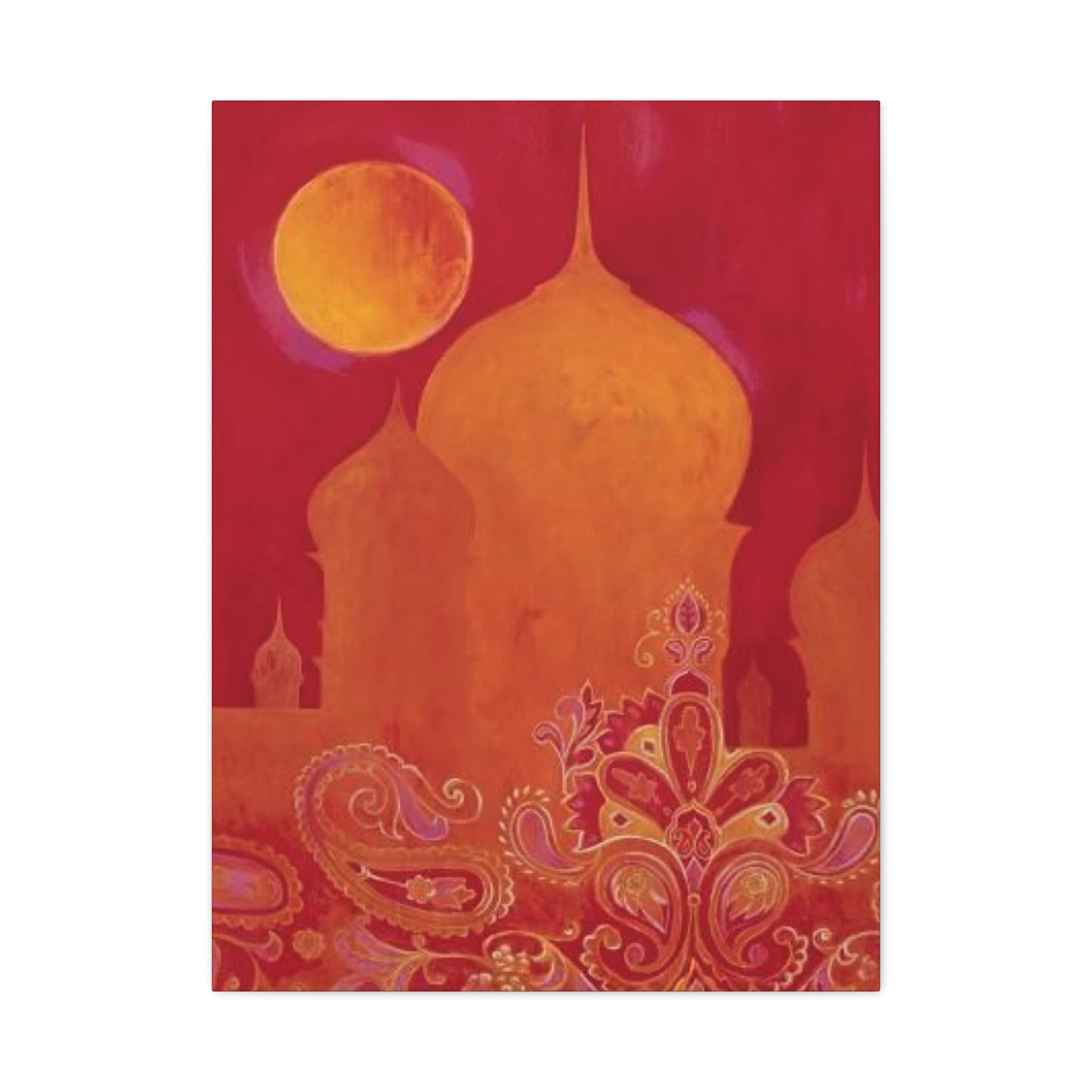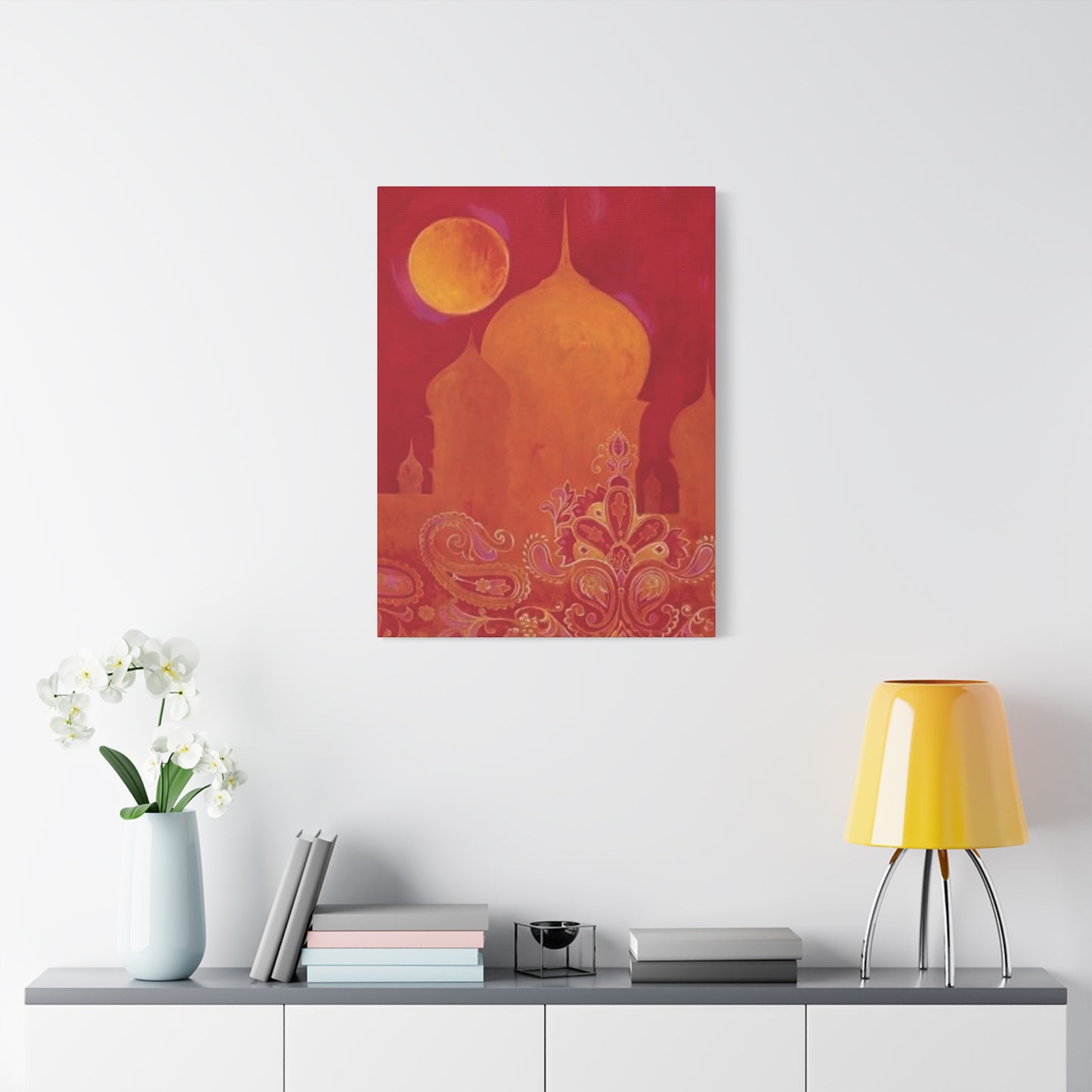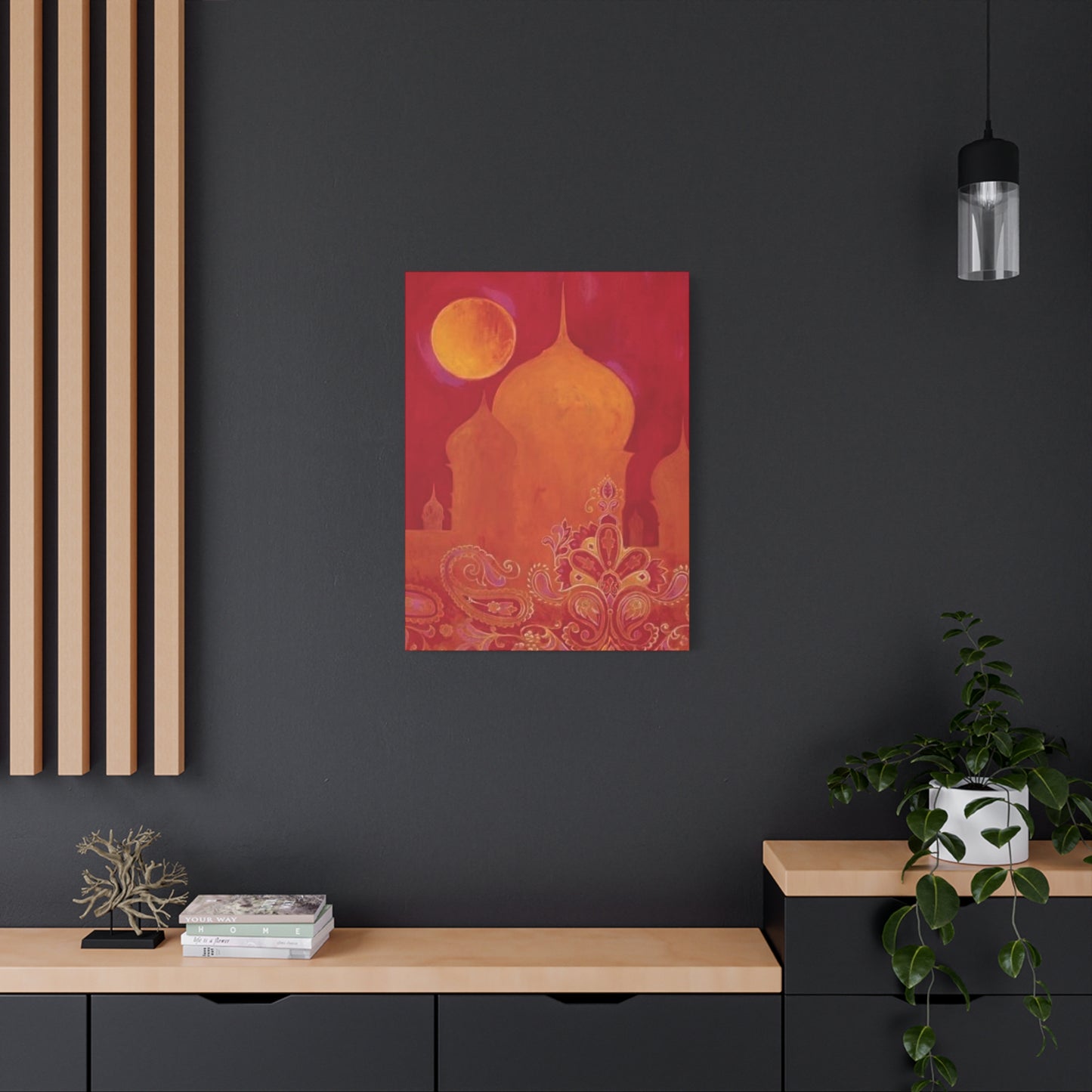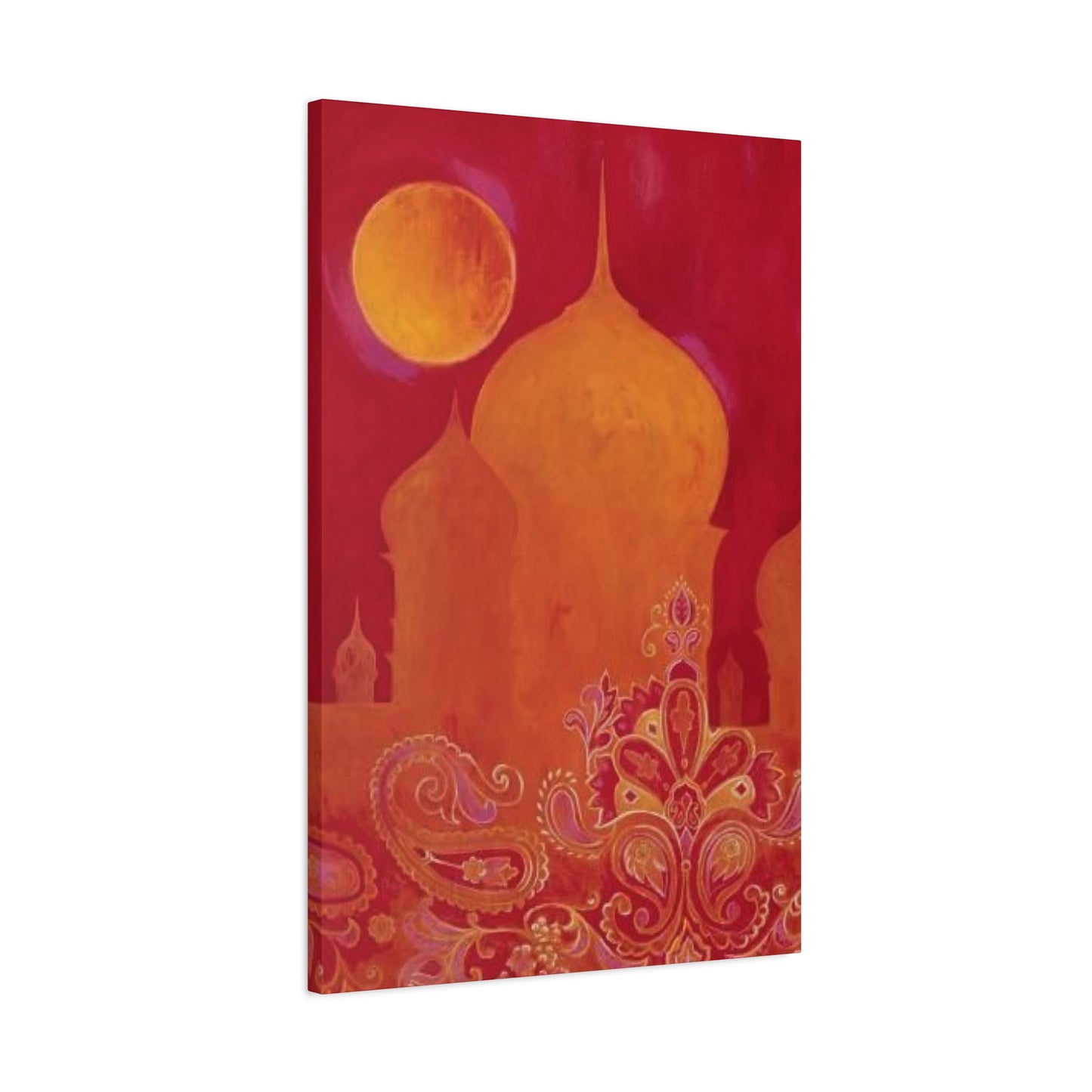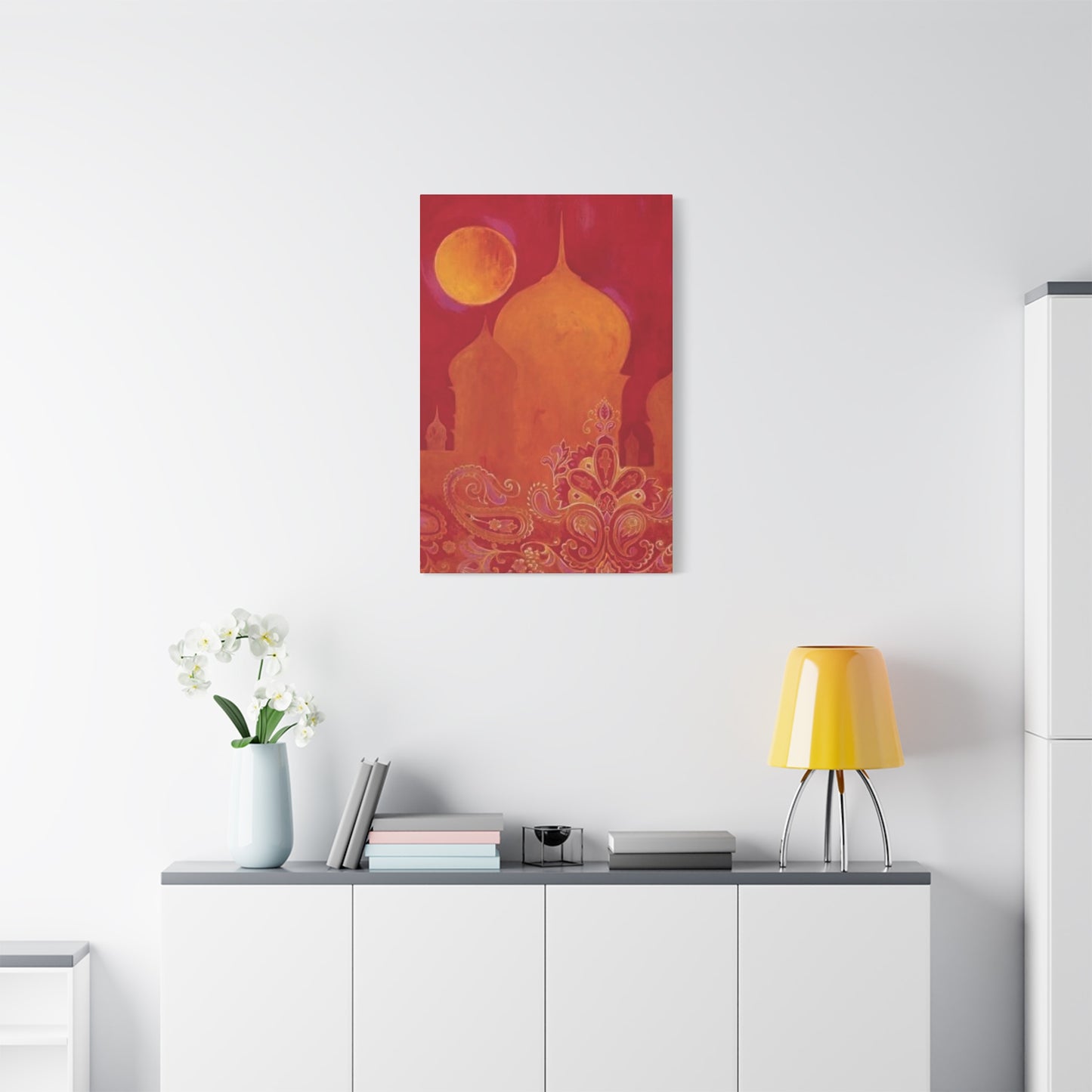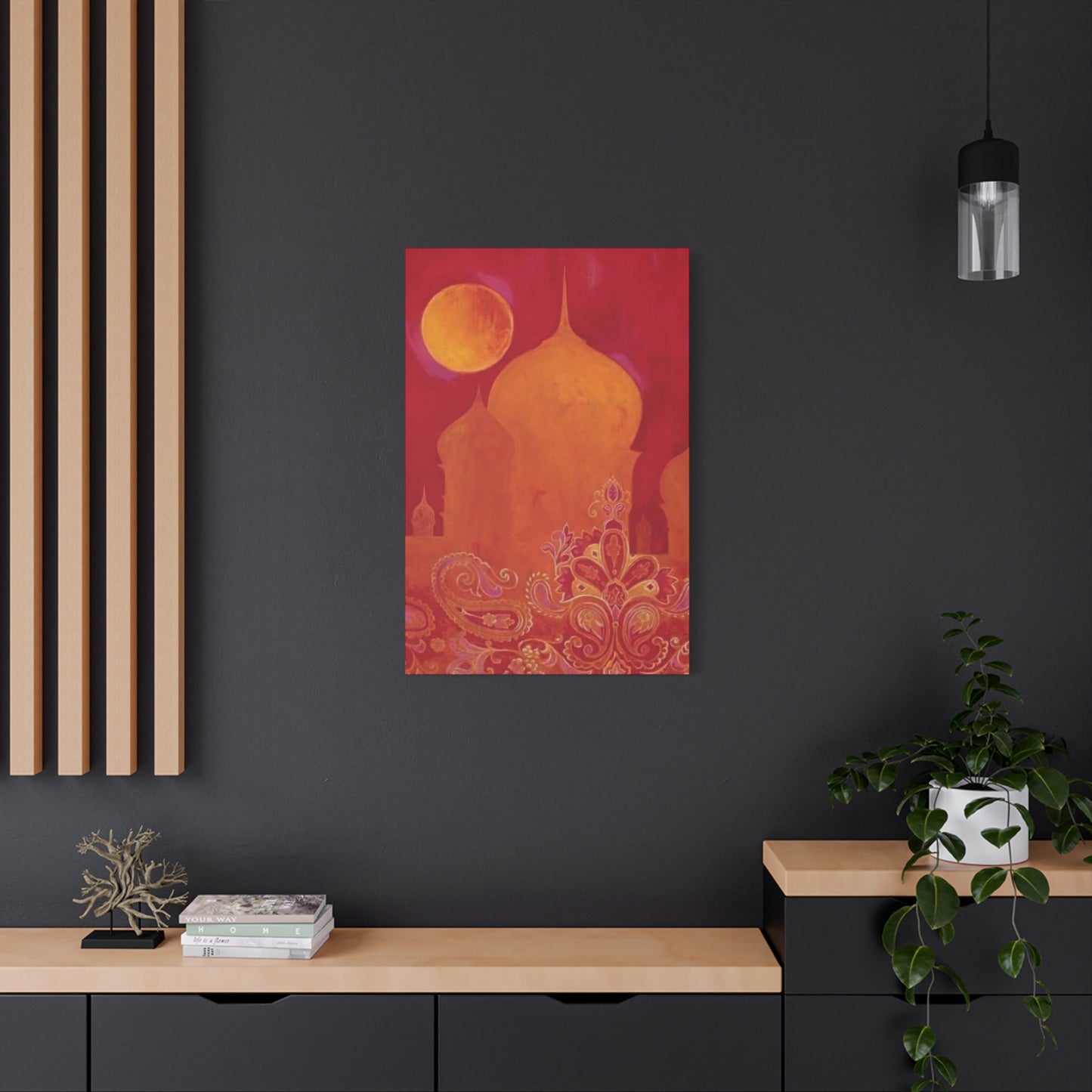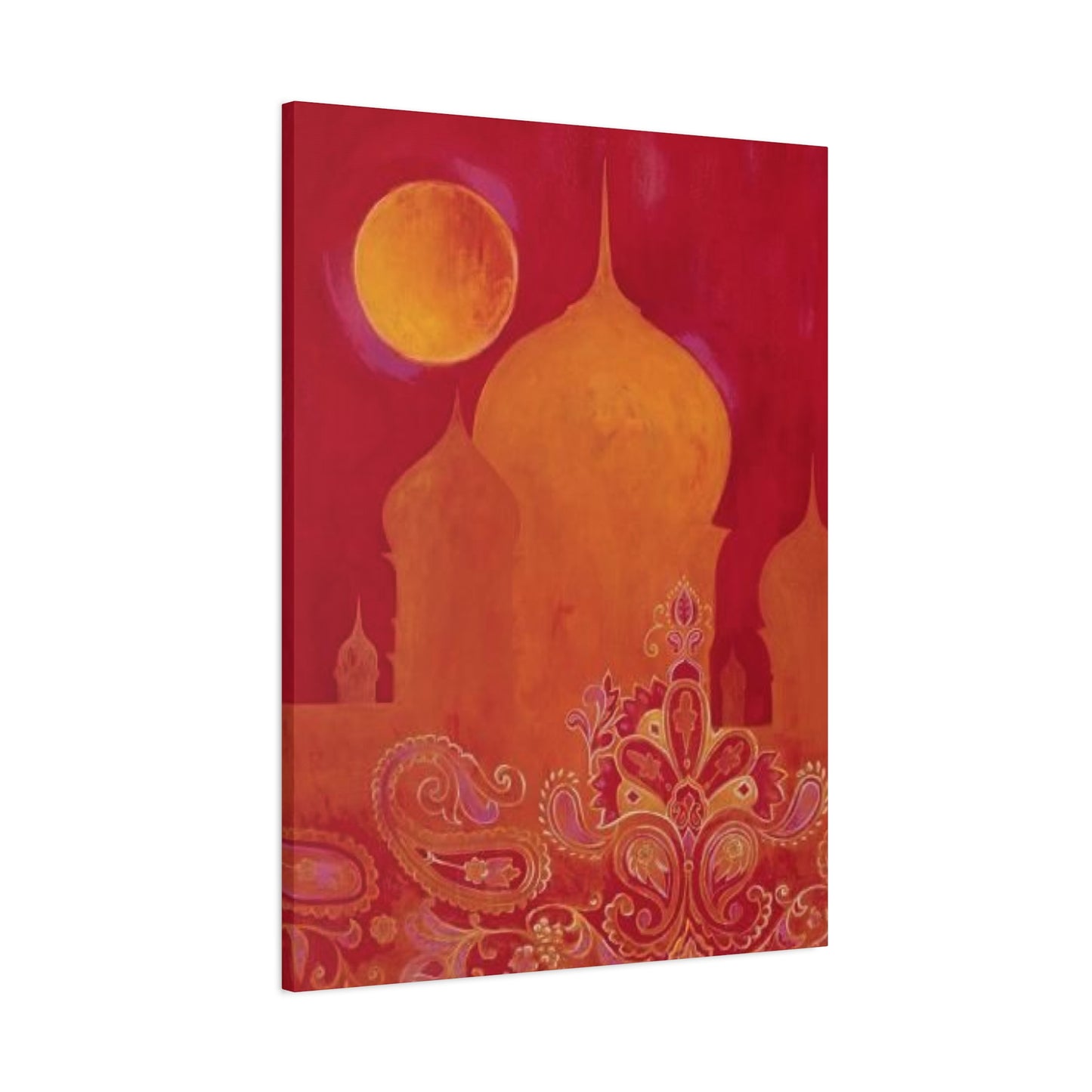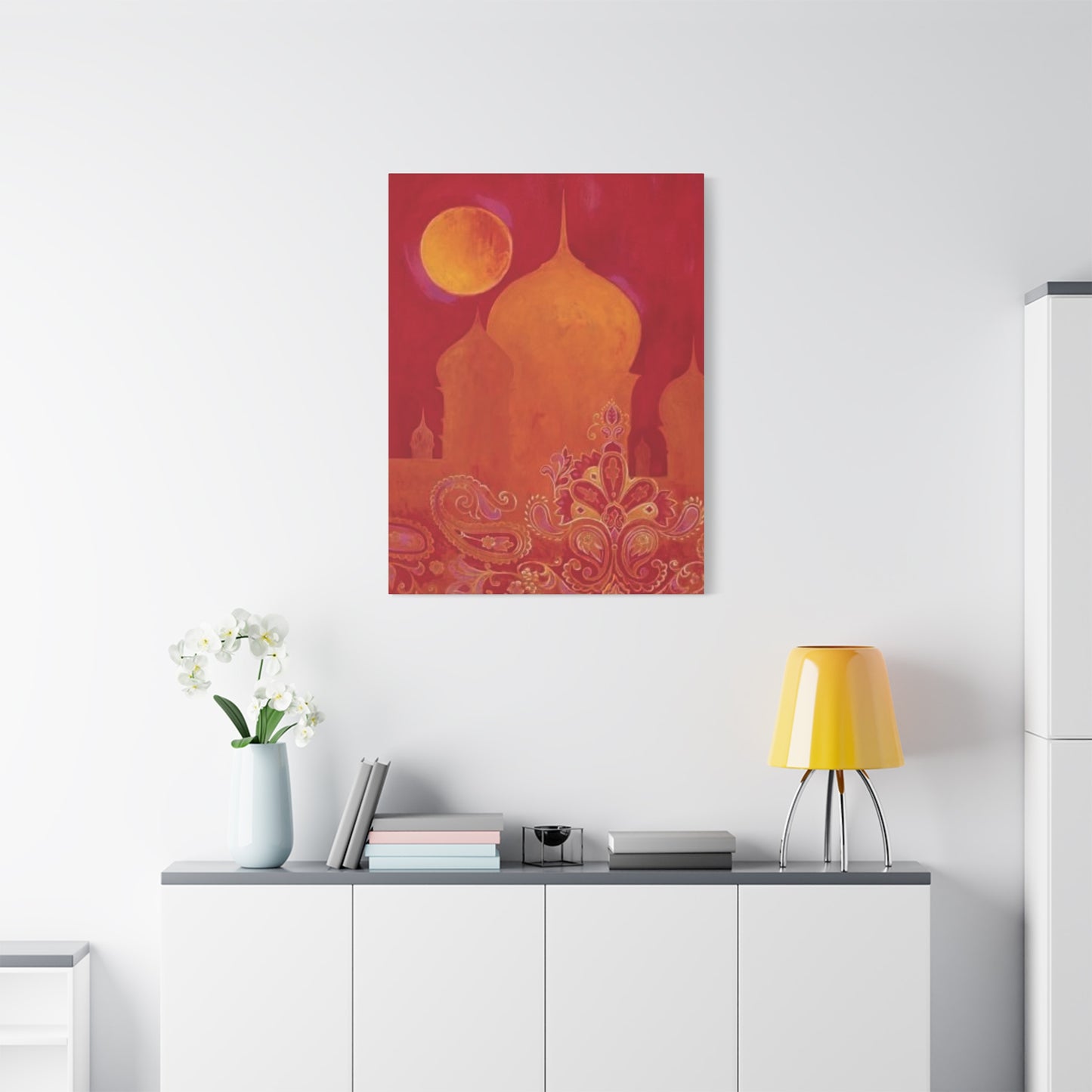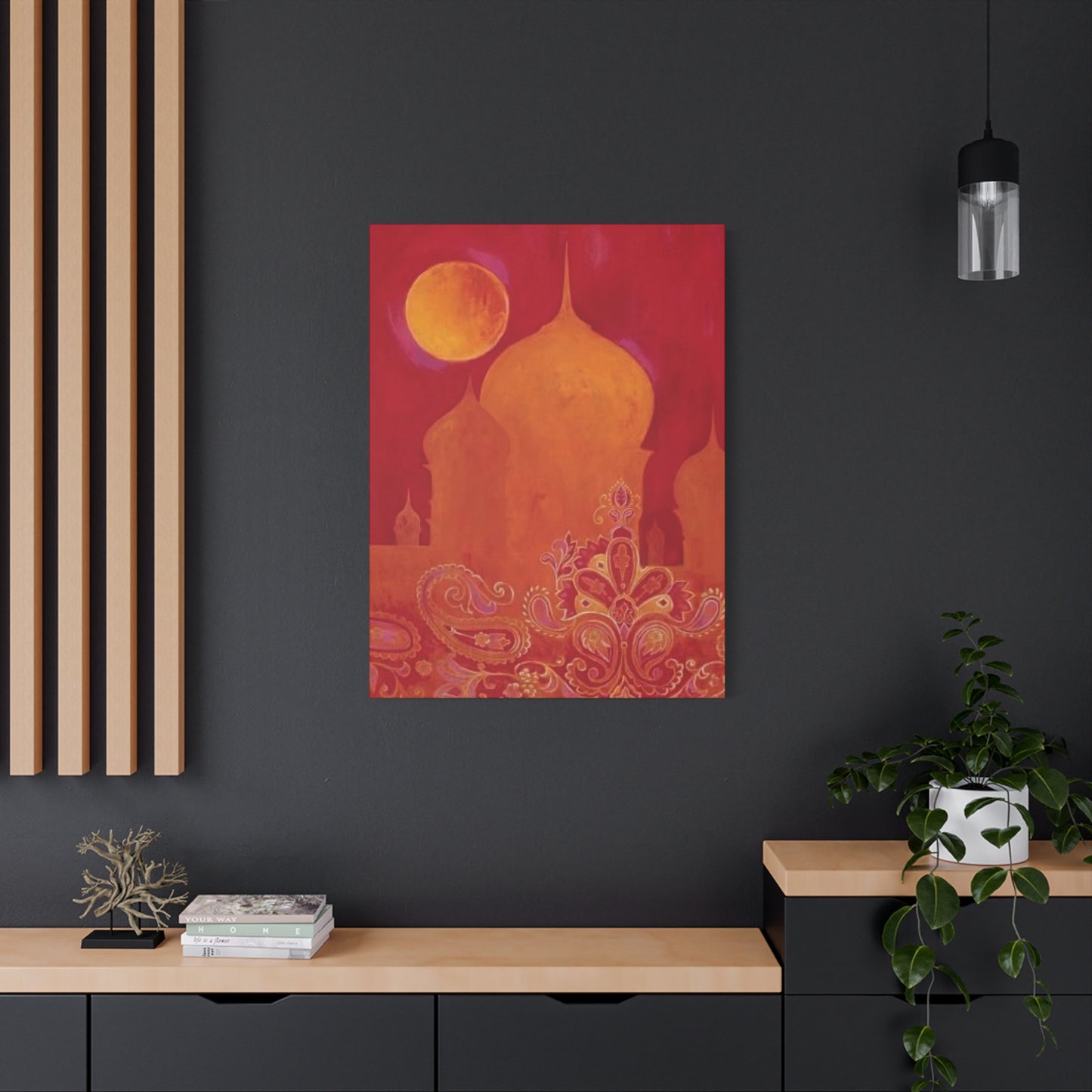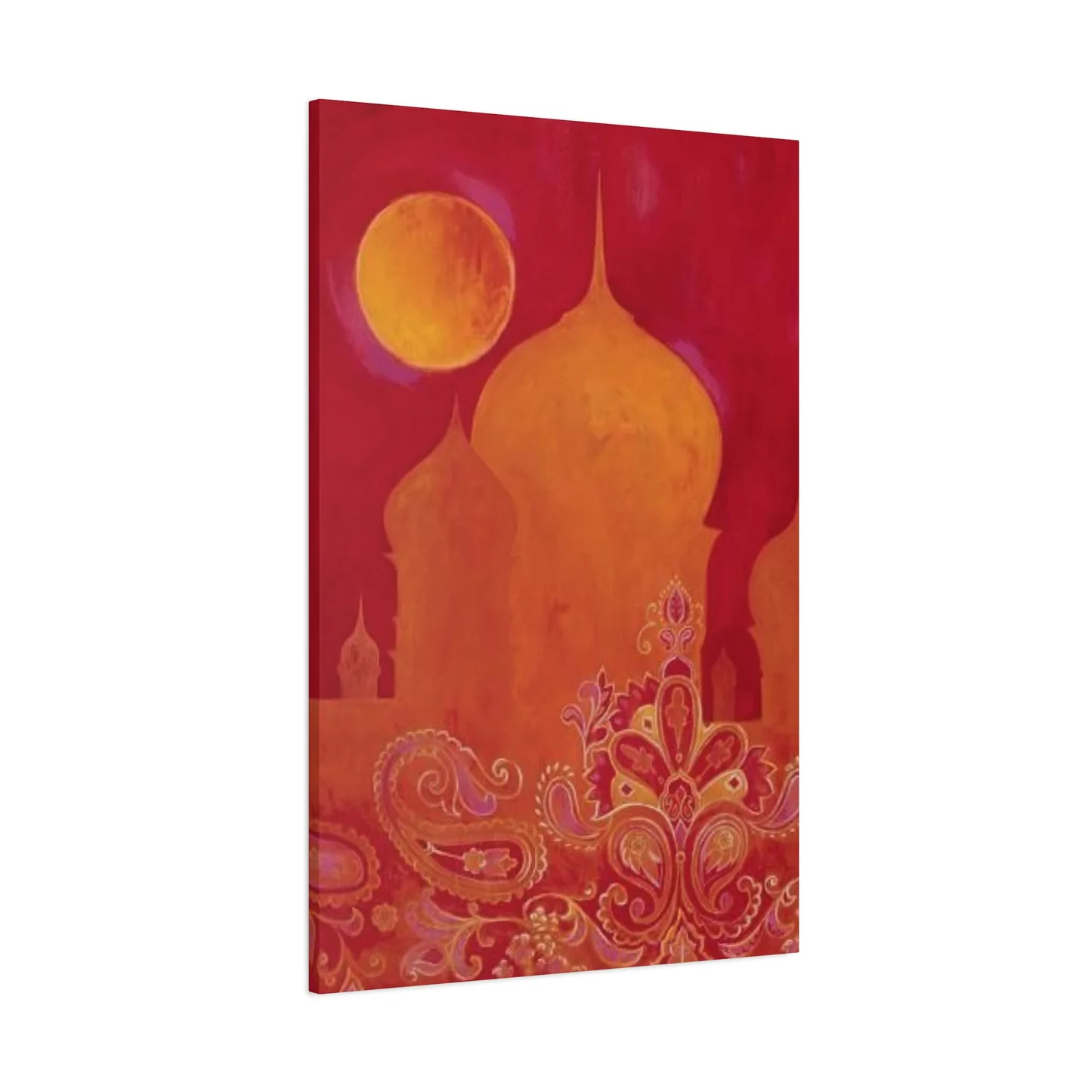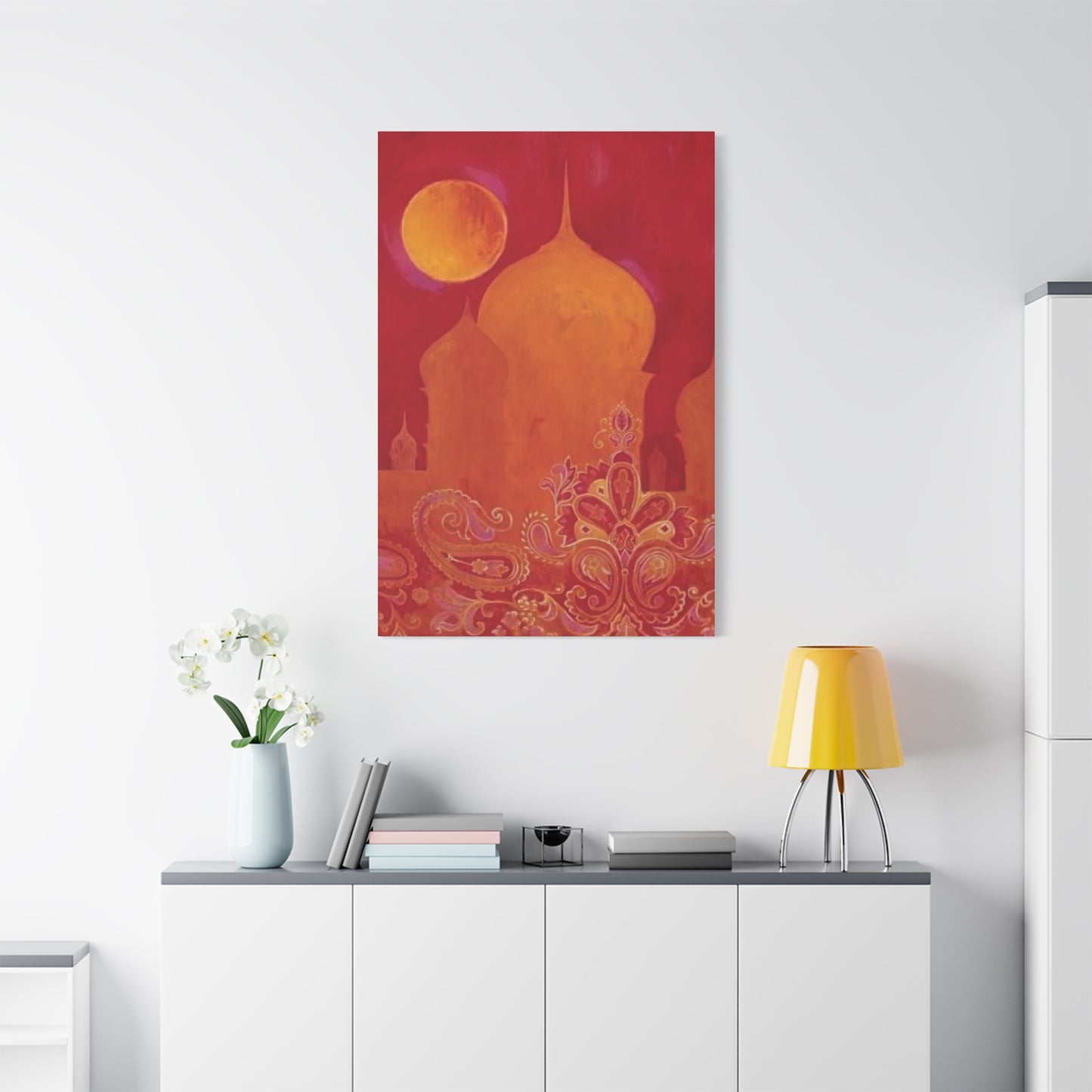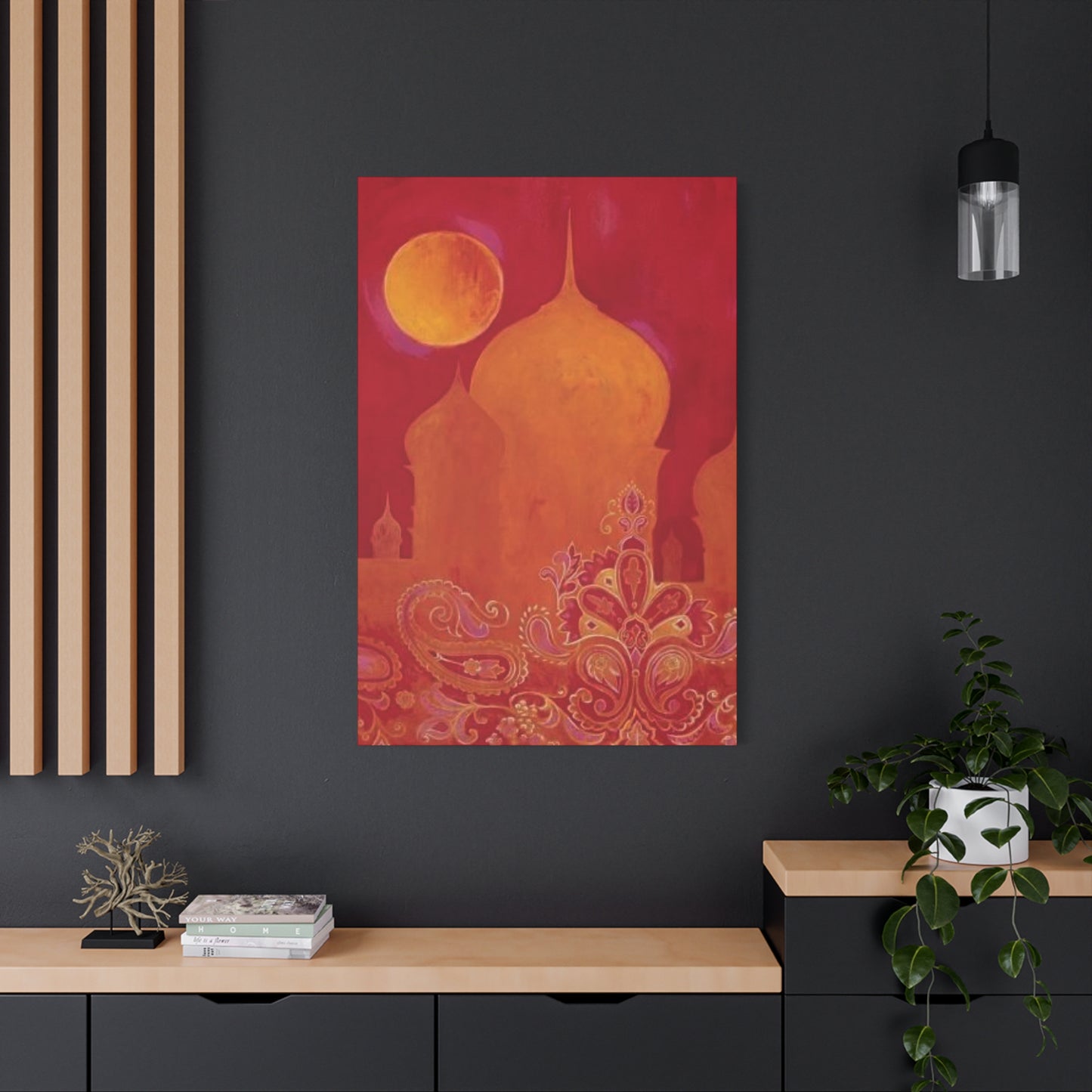Red Moon Moroccan Wall Art: Celestial Beauty Meets Desert Heritage
The fusion of celestial imagery with traditional Moroccan artistry creates a captivating design movement that brings the mystique of moonlit desert nights into contemporary living spaces. This artistic style combines the rich cultural heritage of North African design with the universal appeal of lunar symbolism, resulting in wall art that speaks to both wanderlust and spiritual connection. The deep crimson hues of the moon paired with intricate geometric patterns characteristic of Moroccan craftsmanship offer a distinctive aesthetic that transforms ordinary walls into portals of cultural and cosmic wonder.
Lunar Magic on Your Walls
Bringing lunar magic into interior spaces through Moroccan-inspired artwork creates an atmosphere of enchantment and mystery that few other design choices can achieve. The moon has long been a symbol of transformation, intuition, and the cyclical nature of life across cultures worldwide. When this celestial body is rendered in the rich artistic traditions of Morocco, it takes on additional layers of meaning tied to desert spirituality and ancient wisdom. The placement of moon-themed art on walls serves as a constant reminder of the natural rhythms that govern our lives and the timeless beauty of the night sky.
The magical quality of lunar artwork stems from its ability to evoke emotion and contemplation. A crimson moon suspended against a backdrop of traditional Moroccan patterns draws the eye and invites meditation on the mysteries of existence. These pieces function as more than mere decoration; they become focal points that anchor a room's energy and establish its mood. The interplay between the circular form of the moon and the angular geometry typical of Moroccan design creates visual tension that keeps the artwork engaging no matter how many times you view it.
Creating lunar magic within your home requires careful consideration of placement and lighting. Moon artwork positioned where natural light can interact with it throughout the day will reveal different aspects of the piece as shadows shift and ambient light changes. During evening hours, strategic artificial lighting can make the crimson tones glow with an inner fire, mimicking the appearance of an actual moon hanging low on the desert horizon. The transformative power of lunar imagery becomes most apparent during these twilight hours when the boundary between day and night blurs.
The psychological impact of lunar symbolism in living spaces should not be underestimated. The moon represents the subconscious mind, dreams, and hidden aspects of personality in many spiritual traditions. By incorporating moon imagery into daily surroundings, you create subtle reminders to honor intuition and embrace the unknown. The Moroccan artistic context adds depth to this symbolism by connecting it to specific cultural practices around lunar observation, traditional calendars based on moon phases, and the role of moonlight in desert navigation and storytelling.
Collecting lunar-themed Moroccan art becomes a journey of personal discovery as you explore different artistic interpretations of this celestial body. Some artists emphasize the scientific aspects of the moon, rendering craters and surface details with precision, while others take a more symbolic approach, presenting the moon as a pure circle of color and light. The variety of available styles means that whether your aesthetic leans toward minimalism or maximalism, authentic representation or abstract interpretation, you can find pieces that speak to your individual sense of lunar magic.
Moroccan Nights, Red Moonlight
The phenomenon of the red moon has captivated observers throughout human history, and in Moroccan culture, these celestial events hold particular significance. When the moon appears crimson in the sky, whether due to atmospheric conditions, lunar eclipses, or its position near the horizon, it creates a spectacle that has inspired poets, mystics, and artists for generations. Moroccan nights illuminated by red moonlight possess a quality of otherworldliness, as if the normal rules of reality have been temporarily suspended and replaced with something more primal and mysterious.
Capturing this atmospheric quality in artwork requires artists to master the interplay of color, texture, and composition. The deep reds and oranges of a moon seen through desert dust or smoke must be balanced against the cooler tones of the night sky and the earth below. Traditional Moroccan pigments, derived from natural sources like henna, saffron, and ochre, lend authenticity to these representations, connecting contemporary pieces to centuries of artistic practice. The textural quality of hand-applied paint or ink mimics the grainy appearance of the actual moon when viewed through atmospheric disturbances.
The cultural context of Moroccan nights adds layers of meaning to red moon imagery. In desert communities, night has traditionally been a time of gathering, storytelling, and celestial observation. The appearance of an unusually colored moon would become a topic of discussion and interpretation, with elders sharing traditional knowledge about lunar cycles and their significance. This communal aspect of moon-watching is reflected in artwork that depicts not just the celestial body itself but also the landscape and architectural elements that frame it, suggesting human presence and cultural context.
Red moonlight transforms familiar landscapes into alien territories where shadows deepen and colors shift in unexpected ways. Artists working in this theme often incorporate elements of Moroccan architecture like minarets, archways, and domed roofs as silhouettes against the luminous sky. These structural elements serve multiple purposes: they provide scale that emphasizes the moon's magnitude, they anchor the composition in recognizable cultural context, and they create interesting geometric shapes that complement the moon's circular form. The interplay between built environment and natural phenomenon speaks to humanity's eternal relationship with the cosmos.
The emotional resonance of red moonlight scenes taps into deep-seated human responses to color and light. Red is simultaneously the color of passion and danger, warmth and warning. When applied to the moon, traditionally associated with cool silver light, it creates a compelling contradiction that heightens visual interest and psychological impact. This color choice can make spaces feel more intimate and cozy or more dramatic and theatrical depending on the surrounding design elements and the specific shades of red employed in the artwork.
Boho Decor with a Celestial Twist
The bohemian design philosophy emphasizes individual expression, cultural eclecticism, and connection to artistic traditions from around the world. When celestial themes intersect with this aesthetic, the result is a design approach that celebrates both earthly cultural richness and cosmic wonder. Moroccan-inspired red moon artwork fits perfectly within this paradigm, offering the handcrafted authenticity and cultural depth that bohemian spaces prize while introducing the universal symbolism of lunar imagery that transcends any single cultural tradition.
Bohemian interiors thrive on layering textures, patterns, and colors in ways that might seem chaotic but ultimately achieve a harmonious whole. The addition of celestial elements like moon artwork introduces a unifying theme that can tie together disparate decorative objects. A crimson moon rendered in Moroccan style becomes a focal point around which other design elements can orbit, creating visual cohesion without sacrificing the eclectic spirit essential to successful bohemian design. The circular form of the moon provides a counterpoint to the many angular shapes typically found in furniture and architectural features.
The celestial twist in bohemian decor speaks to a spiritual dimension that has always been part of this design philosophy. Bohemian style emerged from communities of artists and free-thinkers who often explored alternative spiritualities and philosophies. Moon symbolism connects with these interests by representing cycles, transformation, and the hidden aspects of reality that lie beyond immediate perception. Moroccan artistic traditions bring their own spiritual dimensions rooted in Islamic geometry, mystical poetry, and desert asceticism, creating a rich tapestry of meaning in what might initially appear to be simple decorative objects.
Incorporating celestial Moroccan art into bohemian spaces requires attention to color coordination and visual balance. The deep reds common in this artistic style pair beautifully with the warm earth tones, jewel colors, and metallic accents typical of bohemian palettes. Gold frames or mounting hardware can echo the metallic threads often found in Moroccan textiles, creating subtle connections between wall art and other decorative elements. The goal is to make the artwork feel like an integral part of the room's story rather than an afterthought or isolated element.
The handcrafted quality essential to both Moroccan artistic traditions and bohemian aesthetics cannot be overstated. Mass-produced prints lack the soul and individuality that give spaces true character. Seeking out pieces created by actual artists working in traditional or contemporary Moroccan styles ensures that your wall art carries the energy and intention of its maker. This connection to human creativity and craftsmanship aligns perfectly with bohemian values around supporting artisans, preserving traditional techniques, and surrounding oneself with objects that tell stories and carry meaning beyond their immediate visual appeal.
Red Moon Meets Moorish Design
Moorish design represents one of the most sophisticated architectural and decorative traditions in human history, characterized by intricate geometric patterns, flowing calligraphic elements, and a mastery of spatial harmony that continues to influence contemporary designers. When the symbol of the red moon is incorporated into this aesthetic framework, it creates a dialogue between the organic celestial form and the precisely calculated patterns of Islamic geometric art. This meeting of curved and angular, cosmic and cultural, produces artwork that satisfies both intellectual appreciation and emotional response.
The geometric foundations of Moorish design are rooted in mathematical principles that ancient artisans understood intuitively through practice even before the formal mathematics underlying their work was fully articulated. Star patterns, tessellations, and interlocking shapes create the impression of infinite continuation, suggesting that the visible pattern is merely a window into an underlying order that extends beyond the frame. Placing a red moon within or against these patterns creates a focal point that represents both completion and mystery, the known circle containing the unknown depths of celestial nature.
Color theory in Moorish design traditionally emphasizes the interplay of warm and cool tones, with reds, golds, and oranges contrasting against blues, greens, and whites. The red moon naturally fits into this color palette while also carrying specific cultural associations within Islamic artistic traditions. Red has been used in mosque decoration, manuscript illumination, and textile arts for centuries, making its use in lunar imagery feel both fresh and deeply connected to historical precedent. The specific shades of red chosen by contemporary artists working in this style can reference traditional pigments while also expressing modern sensibilities.
Architectural elements common in Moorish design, such as horseshoe arches, muqarnas (honeycomb vaulting), and intricate latticework, provide rich contextual frameworks for lunar imagery. A red moon viewed through an elaborately decorated arch creates layers of meaning about perspective, framing, and the relationship between earthly craft and heavenly bodies. These compositional strategies allow artists to showcase both the moon itself and the cultural traditions through which it is being observed, creating artwork that functions as both portrait of a celestial object and documentation of cultural aesthetic values.
The spiritual dimensions of Moorish design add contemplative depth to red moon artwork. Islamic artistic traditions developed in contexts where religious practice emphasized meditation on divine order and the signs of creation visible in nature. Geometric patterns were understood as reflections of the underlying mathematical harmony of creation, while celestial bodies like the moon were seen as evidence of divine design. Contemporary artists working in these traditions may approach their work from secular perspectives, but the historical spiritual context inevitably influences the formal qualities of their art and the responses it evokes in viewers.
Desert Moon Wall Vibes
The desert landscape exerts powerful influence on artistic imagination, representing both physical challenge and spiritual opportunity. Desert moons, appearing larger and more luminous in atmospheres free from urban light pollution, have guided travelers, inspired mystics, and marked the passage of time for nomadic peoples throughout history. Capturing this specific environmental and cultural context in wall art requires understanding both the visual qualities of desert moonlight and the emotional associations these landscapes carry for diverse audiences.
Desert moon imagery evokes feelings of solitude, contemplation, and connection to elemental forces. The vast empty spaces of desert landscapes, rendered as simplified forms or suggested through minimal detail, provide stark contrast to the visual complexity of the moon itself or the decorative patterns that might frame it. This contrast between emptiness and elaboration, silence and expression, creates tension that keeps artwork visually engaging. The desert context also introduces themes of survival, adaptation, and the resilience required to thrive in challenging environments, adding metaphorical dimensions to what might otherwise be purely aesthetic objects.
The color palette associated with desert environments ranges from the warm ochres and siennas of sand and rock during daylight to the surprisingly cool blues and purples that emerge under moonlight. Artists working with desert moon themes must navigate these color relationships carefully to achieve both visual harmony and atmospheric authenticity. The red moon introduces a third color element that must be balanced against both warm earth tones and cool night sky hues, creating opportunities for sophisticated color composition that rewards extended viewing.
Textural elements in desert moon wall art can reference the grainy quality of sand, the rough surfaces of desert rocks, or the smooth curves of wind-sculpted dunes. These textures can be achieved through various artistic techniques including impasto painting, mixed media applications, or the incorporation of actual sand and other natural materials into the artwork. The textural variety adds tactile interest even in two-dimensional works and suggests the physical reality of desert environments beyond their purely visual qualities.
The cultural associations of deserts in Moroccan contexts include Berber heritage, nomadic lifestyles, and the spiritual traditions of desert mystics and saints. Wall art incorporating these elements connects viewers to specific historical and cultural narratives rather than presenting deserts as empty abstract spaces. Subtle inclusion of traditional desert dwelling structures, caravan routes, or native plant life can ground lunar imagery in particular geographical contexts while still maintaining the universal accessibility of celestial symbolism. This balance between specific cultural reference and broader human experience characterizes the most successful examples of this artistic genre.
Ethnic Patterns, Cosmic Themes
The intersection of ethnic patterns with cosmic themes creates artwork that speaks to humanity's dual nature as both culturally specific beings rooted in particular traditions and universal creatures sharing common experiences of wonder at natural phenomena. Moroccan ethnic patterns carry centuries of refinement, with specific motifs and color combinations developing distinct meanings and associations within various communities. When these culturally encoded designs frame or incorporate cosmic imagery like red moons, they create multilayered communication that operates on aesthetic, cultural, and symbolic levels simultaneously.
Traditional Moroccan patterns derive from multiple cultural influences including Arab, Berber, African, and Andalusian sources, creating a rich visual vocabulary that contemporary artists continue to explore and reinterpret. Geometric patterns based on star forms create natural associations with celestial themes, while organic patterns inspired by plants, water, and landscape features connect cosmic elements to earthly nature. The skilled combination of these pattern types in a single composition demonstrates artistic mastery while also reflecting the cultural synthesis that characterizes Moroccan identity.
Cosmic themes introduce universal symbols that transcend specific cultural contexts while still gaining particular meanings through their presentation within ethnic artistic frameworks. The moon appears in the mythologies and artistic traditions of cultures worldwide, but its rendering in Moroccan style connects it specifically to North African cultural perspectives on lunar significance. This cultural specificity does not limit the artwork's accessibility; rather, it enriches meaning by offering viewers access to particular wisdom traditions while still engaging with broadly recognizable celestial imagery.
The technical execution of ethnic patterns requires precision and patience, whether created through traditional hand-painting, tile work, textile techniques, or contemporary digital methods subsequently translated into physical form. The repetitive nature of pattern work can induce meditative states in both creators and viewers, linking the process of making and experiencing this art to spiritual practices around focused attention and mindfulness. When these precisely executed patterns surround or incorporate the organic form of a moon, the contrast highlights both the order humans impose through culture and the wildness that persists in natural phenomena.
Contemporary artists working with ethnic patterns and cosmic themes navigate questions about cultural appropriation, authentic expression, and the evolution of traditional forms. The most respectful and successful approaches involve deep study of pattern traditions, understanding the cultural contexts from which they emerged, and either working within one's own heritage or collaborating with artisans from the relevant cultural communities. The goal is to honor tradition while allowing for creative innovation, maintaining the integrity of cultural forms while also enabling them to speak to contemporary concerns and aesthetics.
A Touch of Marrakech Moonlight
Marrakech, the red city of Morocco, holds special place in cultural imagination as a crossroads of African, Arab, and European influences, a marketplace of ideas and goods, and a center of artistic innovation. Moonlight in Marrakech takes on particular character as it illuminates the distinctive red-pink clay architecture that gives the city its nickname, creating color harmonies quite different from moonlight elsewhere. Capturing this specific quality in artwork requires attention to both the general characteristics of moonlit scenes and the particular visual signatures of this unique urban environment.
The architecture of Marrakech, with its flat roofs, central courtyards, and minimal window openings on exterior walls, creates distinctive silhouettes under moonlight. These architectural forms, rendered in the red tones of local clay mixed with straw, provide the middle ground between the dark earth below and the luminous sky above. Artists depicting Marrakech moonlight must carefully calibrate these three tonal zones to achieve the atmospheric depth that makes such scenes memorable. The addition of a red moon introduces a fourth tonal element that must harmonize with the city's red architecture without creating confusing visual redundancy.
The medina of Marrakech, with its maze-like streets, hidden gardens, and sudden openings into squares and courtyards, offers endless compositional possibilities for moonlit scenes. A moon glimpsed between buildings at the end of a narrow street creates a sense of discovery and revelation. A moon reflected in the still water of a courtyard fountain doubles its presence while introducing symmetry that balances the complex asymmetry of traditional architecture. These spatial compositions draw viewers into imagined navigation of actual places, creating artwork that functions as both aesthetic object and invitation to armchair travel.
The cultural life of Marrakech, particularly the famous Jemaa el-Fnaa square where performers, storytellers, and food vendors gather, provides human context for moonlit scenes. Including suggestions of human presence through the warm glow of lanterns, the smoke from food stalls, or the simplified forms of figures in traditional dress animates lunar imagery and prevents it from feeling static or purely decorative. These human elements remind viewers that places exist not as backdrops but as living environments where culture continuously unfolds.
The sensory richness of Marrakech extends beyond visual experience to include the sounds of call to prayer, the scents of spices and flowers, and the tactile qualities of tile, wood, and textile. While visual artwork cannot directly convey these other sensory dimensions, skilled artists can suggest multisensory richness through compositional complexity, textural variety, and the inclusion of elements that trigger associative memory in viewers who have visited Morocco or who have experienced similar environments elsewhere. This suggestive power transforms simple wall art into evocative triggers for imagination and memory.
Bold Red Moons in Tribal Style
Tribal art styles across cultures share certain characteristics including stylization rather than naturalistic representation, emphasis on symbolic meaning over literal depiction, and connection to communal identity and spiritual practice. When applied to lunar imagery, tribal aesthetic approaches create moon representations that feel archetypal and timeless rather than tied to specific moments or scientific understanding. Bold red moons rendered in tribal style tap into primal human responses to celestial phenomena, bypassing intellectual analysis to speak directly to intuitive and emotional centers.
The use of bold, simplified forms in tribal art serves multiple purposes including visual impact, easy reproduction in various media, and clear communication of symbolic content. A tribal-style red moon might be rendered as a simple circle of intense color, perhaps with minimal interior detail suggesting craters or texture, surrounded by geometric or organic patterns that denote rays, atmosphere, or spiritual energy. This visual economy makes such images powerful even at small scales while also allowing them to command attention when enlarged to fill entire walls.
Color choices in tribal art traditionally derive from available natural pigments and carry symbolic associations developed over generations. Red specifically appears across many tribal traditions as a color of life force, blood, fire, and transformative power. Applying red to the moon, which many traditions associate with feminine energy, emotional tides, and cyclic time, creates rich symbolic layering. Contemporary artists working in tribal styles may use synthetic pigments that achieve more intense or stable colors than traditional materials, but successful work maintains the color relationships and symbolic resonances of historical precedents.
The integration of tribal patterns with lunar imagery requires understanding both the aesthetic logic of pattern traditions and the symbolic frameworks they encode. In many tribal traditions, specific patterns indicate clan membership, spiritual status, or connections to particular natural forces or animal spirits. While contemporary artists may not intend their work to function within these original cultural systems, awareness of pattern meanings prevents inappropriate use and enables more intentional symbolic communication. Even when working in generalized tribal styles rather than reproducing specific cultural patterns, maintaining respect for the serious purposes these visual languages originally served keeps artwork from devolving into mere decoration.
The display of tribal-style red moon artwork connects contemporary living spaces to ancient human practices of marking dwelling places with protective symbols, clan identifications, and representations of power sources. This connection operates mostly at unconscious levels but contributes to the sense that such artwork provides more than visual pleasure—it performs some subtle protective or energizing function within the home environment. Whether viewers intellectually accept these traditional functions or not, the persistence of human responses to bold symbolic imagery suggests that surrounding ourselves with such images does affect mood, psychology, and sense of security in ways we don't fully understand.
Celestial Meets Moroccan Chic
The concept of chic implies effortless sophistication, carefully curated aesthetic choices, and adherence to high standards of quality and design intelligence. Moroccan chic as a design movement emerged from the international discovery of Moroccan design traditions by fashion designers, decorators, and taste-makers who recognized the potential to adapt traditional forms for contemporary luxury contexts. When celestial imagery enters this aesthetic framework, it must maintain the sophistication and refinement that characterize chic design while adding the sense of wonder and cosmic connection that celestial symbols provide.
Achieving celestial Moroccan chic in wall art requires restraint in composition, excellence in execution, and careful color coordination. Not every piece needs to be visually complex or heavily patterned; sometimes a simple moon rendered in subtle gradations of red against a minimal background achieves more sophistication than elaborate compositions. The quality of materials and craftsmanship must be impeccable, as chic audiences can immediately detect inferior work. The overall effect should be one of polished ease, as if the perfect fusion of celestial and cultural elements occurred naturally without apparent effort.
The color palette for celestial Moroccan chic typically emphasizes muted elegance over bright exuberance. Deep burgundies and wine reds replace bright scarlets; dusty roses provide softer options than hot pinks; and these reds are balanced against neutrals like cream, taupe, and warm grays rather than competing with multiple bright colors. Metallic accents in gold, brass, or copper add luxury without overwhelming, often appearing in frames, mounting hardware, or subtle details within the artwork itself. This sophisticated color approach ensures that bold celestial imagery integrates smoothly into refined contemporary interiors.
The scale and placement of artwork significantly impact its effectiveness in chic design contexts. Oversized pieces making bold statements work best in spaces with adequate wall area and minimal competing visual elements. Multiple smaller coordinated pieces can create gallery walls that add interest without overwhelming. The relationship between artwork and surrounding furnishings must be carefully considered, with moon imagery often serving as the room's focal point around which other design elements arrange themselves. Professional consultation with designers can help determine optimal sizing and placement for maximum impact.
The cultural authenticity underlying celestial Moroccan chic separates it from superficial trend-chasing. Chic design audiences increasingly value genuine cultural connections and ethically sourced objects over mass-produced imitations. Seeking out artists with actual ties to Moroccan traditions, whether through heritage, training, or sustained engagement with the culture, ensures that your wall art contributes to cultural preservation and artist support rather than exploitation. This ethical dimension has become integral to contemporary understandings of what makes design truly sophisticated rather than merely expensive or stylish.
Hand-Painted Red Moon Art
Hand-painted artwork carries unique qualities that mechanical reproduction cannot capture, including visible brushstrokes that record the artist's physical engagement with materials, subtle color variations created by mixing paint on palette or canvas, and the indefinable quality of presence that comes from direct human creation. Hand-painted red moon art represents significant investment of artistic time and skill, resulting in one-of-a-kind pieces that carry greater value both monetarily and emotionally than printed reproductions, no matter how skillfully executed.
The process of hand-painting lunar imagery in Moroccan style requires mastery of multiple technical skills including color mixing, brush control, and compositional planning. Creating the perfect red for a moon involves understanding pigment characteristics, how colors shift as paint dries, and how the chosen red will interact with surrounding colors in the composition. Achieving smooth gradations that suggest the moon's spherical form or deliberately textured surfaces that evoke lunar craters requires different brush techniques and varying paint consistencies. Background elements and decorative patterns demand their own technical approaches, all of which must be coordinated to create unified final results.
The choice of painting surface significantly affects the final character of hand-painted moon art. Traditional stretched canvas provides tooth that grabs paint and allows for easy reworking, while also offering durability for artworks intended to last generations. Wood panels provide rigid surfaces that prevent warping and can be prepared with traditional gesso techniques to create perfectly smooth grounds for detailed work. Paper, whether heavy watercolor paper or specially prepared boards, offers different absorbency qualities that affect how paint behaves and appears. Some contemporary artists work on unconventional surfaces including metal, fabric, or found objects, creating unique textural and contextual dimensions.
The spiritual and energetic dimensions of hand-painted art derive from the focused intention and sustained attention artists bring to their work. Many artists report entering flow states during painting where normal consciousness shifts and creative decisions seem to arise from deeper intuitive sources rather than analytical thinking. This creative energy becomes embedded in the finished work and can be sensed by sensitive viewers even if they cannot articulate what makes a particular piece feel vital versus merely decorative. Collectors of hand-painted art often describe developing personal relationships with specific pieces that go beyond appreciation of technical skill or aesthetic beauty.
Commissioning hand-painted red moon art allows for complete customization in terms of size, color specifics, compositional elements, and symbolic content. Artists working on commission collaborate with clients to understand the intended display context, desired emotional tone, and any personal or cultural references that should be incorporated. This collaborative process creates artwork specifically tailored to individual needs and spaces rather than requiring compromises to accommodate available ready-made pieces. The resulting art carries additional meaning through its connection to the commissioning process and the relationship between artist and patron.
Rich Reds and Geometric Motifs
The combination of rich red tones with geometric motifs creates visual experiences that are simultaneously warm and intellectual, emotionally engaging and formally rigorous. Rich reds span a spectrum from deep burgundies approaching black to bright vermilions verging on orange, each shade carrying different psychological associations and working differently with geometric patterns. The precision required for geometric motifs provides counterpoint to the emotional intensity of red, creating balance that prevents artwork from becoming either too coldly mathematical or too emotionally overwhelming.
Geometric motifs in Moroccan traditions derive from mathematical principles of symmetry, tessellation, and proportion that create pleasing visual harmonies. Star patterns, interlocking polygons, and repeating arabesques demonstrate sophisticated understanding of plane geometry and its aesthetic possibilities. When executed in rich red tones, these patterns gain warmth and vitality that purely monochrome or cool-colored versions might lack. The red grounds geometric abstraction in visceral experience, reminding viewers that these patterns emerged from human cultures with hot climates, passionate emotional expressions, and vibrant material cultures.
The interplay between figure and ground becomes particularly interesting when working with red geometric motifs and lunar imagery. The moon can be rendered as negative space within a field of geometric patterns, created through the absence of pattern rather than positive depiction. Alternatively, the moon itself can be filled with geometric patterns, suggesting that even celestial bodies participate in the underlying mathematical order that traditional geometric art celebrates. These compositional strategies create visual puzzles that reward sustained looking as viewers discover the relationships between different elements.
The technical execution of geometric motifs requires tools and techniques that ensure precision despite the hand-crafted nature of the work. Traditional artists used compasses, straightedges, and carefully measured grids to plan their patterns before executing them in paint, tile, or other media. Contemporary artists may use similar traditional tools or employ digital design software to plan patterns that are subsequently translated into hand-painted or hand-crafted form. The slight imperfections that inevitably appear in hand-executed geometric work actually enhance rather than diminish aesthetic quality by providing evidence of human creation and preventing the sterile perfection that can make purely digital designs feel cold.
Psychological research on pattern perception reveals that humans find well-ordered geometric patterns inherently satisfying, perhaps because they reflect cognitive structures we use to organize sensory information. The addition of rich color and meaningful imagery like lunar forms to geometric patterns creates multi-level engagement that activates different brain systems simultaneously. This neurological variety of stimulation contributes to the holding power of successful geometric art—viewers return to it repeatedly without exhausting its interest because different viewing sessions engage different aspects of perception and cognition.
Full Moon Energy in Moroccan Decor
The full moon has been recognized across cultures as a time of heightened energy, emotional intensity, and spiritual opportunity. Incorporating representations of full moons into Moroccan-style decor brings this energetic quality into daily living environments, creating spaces that feel charged with potential and alive with possibility. The visual impact of a full red moon rendered in rich Moroccan style serves as constant reminder of natural cycles, cosmic forces, and the possibility of transformation that each lunar cycle represents.
Full moon energy manifests psychologically as increased emotional awareness, heightened creativity, and sometimes disrupted sleep patterns as the body responds to lunar cycles that governed human activity for millennia before artificial lighting severed our direct connection to natural light-dark rhythms. Decorating with full moon imagery creates environmental triggers that help maintain conscious connection to these cycles even when urban living distances us from direct experience of moonlight's power. The Moroccan design context adds cultural richness to this connection by linking it to specific traditions of lunar observation and celebration.
The color red intensifies the energetic quality of full moon imagery by introducing associations with vitality, passion, and blood that complement the moon's connections to emotional tides and feminine cycles. Blood moons, which actually occur during certain lunar eclipses when Earth's atmosphere filters sunlight to cast reddish light on the lunar surface, provide natural precedent for red moon imagery. Traditional cultures often interpreted blood moons as omens or signals of cosmic significance, adding layers of meaning to artistic representations. Contemporary viewers may or may not accept astrological or mystical interpretations, but the visceral impact of red moon imagery operates independently of intellectual belief systems.
The placement of full moon art within living spaces follows principles of energy flow and focal point creation common to various interior design traditions. A full moon piece positioned where it's visible immediately upon entering a room establishes the space's energetic tone and provides orientation point for arranging other design elements. Full moon art in bedrooms can influence dream life and sleep quality, either supporting restfulness or stimulating vivid dream activity depending on the specific imagery and colors used. Meditation or creative work spaces benefit from full moon energy's associations with heightened awareness and intuitive knowing.
Combining full moon energy with other Moroccan decor elements creates layered environments rich in symbolic meaning and cultural reference. Moroccan lanterns with their intricate cutout patterns can project geometric shadows that complement geometric patterns in moon artwork. Textiles featuring complementary patterns and colors integrate wall art into the overall design scheme. Plants, particularly those that respond visibly to moon phases like some flowering species, add living elements that enact lunar cycles in real time. The cumulative effect is immersive environment that engages multiple senses and operates on multiple symbolic levels simultaneously.
Wall Art for the Bohemian Soul
The bohemian soul seeks beauty beyond conventional definitions, values authenticity over perfection, and finds meaning in cultural depth and artistic intention rather than mere surface decoration. Wall art that truly speaks to bohemian sensibilities must offer layers of meaning to discover, evidence of human hands and hearts in its creation, and connections to cultural traditions that carry wisdom and beauty developed over generations. Red moon Moroccan art fulfills these requirements by combining universal celestial symbolism with specific cultural artistic vocabularies, creating pieces that reward both immediate aesthetic appreciation and sustained contemplation.
The bohemian approach to curating living spaces emphasizes personal narrative and accumulated meaning rather than coordinated design schemes purchased complete from showrooms. Each object should tell a story, whether about travels undertaken, artists supported, cultural traditions honored, or personal evolution reflected in changing aesthetic preferences. Moon art acquired during actual visits to Morocco carries especially powerful meaning as physical reminder of transformative travel experiences, while pieces by Moroccan artists working in diaspora communities connect viewers to ongoing cultural negotiations between tradition and contemporary life.
Color courage characterizes bohemian design sensibilities, with bold jewel tones, earthy organics, and unexpected combinations creating visually rich environments that stimulate rather than soothe. The deep reds common in Moroccan lunar art align perfectly with this chromatic bravery while also introducing cooling celestial elements that prevent color schemes from becoming overwhelming. The circular form of the moon provides visual relief within typically angular room architectures and furniture forms, while the symbolic associations of lunar imagery add contemplative dimension to spaces that might otherwise feel purely sensory and immediate.
The layering essential to successful bohemian interiors applies to wall art arrangements as much as to textiles, furniture, and decorative objects. A single large moon piece might serve as anchor for a gallery wall incorporating smaller complementary works, textile hangings, mirrors, and three-dimensional objects. The goal is to create rich visual compositions that reveal new details with each viewing rather than communicating everything in a single glance. This layered approach reflects bohemian values around depth, complexity, and the rewards of sustained attention in contrast to the instant gratification emphasized by consumer culture.
The global perspective inherent in bohemian style celebrates cultural diversity and seeks beauty in traditions worldwide rather than privileging Western European aesthetic lineages. Moroccan moon art represents just one of many cultural artistic traditions that bohemian souls might incorporate, ideally alongside works from other regions and traditions that together reflect the glorious diversity of human creative expression. This multicultural approach requires cultural sensitivity and awareness to avoid appropriation or superficial tourism, instead aiming for genuine appreciation and respectful engagement with artistic traditions in their full cultural contexts.
The sustainability concerns increasingly important to contemporary bohemian communities extend to art acquisition decisions. Seeking out artists who work with sustainable materials, support fair labor practices, and contribute to cultural preservation aligns art collecting with broader ethical commitments. Purchasing directly from artists or through galleries that ensure artists receive fair compensation supports creative communities and helps maintain traditional crafts that might otherwise disappear under pressure from mass production. These ethical dimensions add satisfaction beyond aesthetic pleasure, making the art on one's walls reflection of values as well as taste.
Berber-Inspired Red Moon Paintings
Berber peoples, the indigenous inhabitants of North Africa predating Arab settlement, possess rich artistic traditions characterized by distinctive symbolic vocabularies, geometric pattern preferences, and connections to pre-Islamic spiritual practices that continue to influence cultural expressions despite centuries of Islamic cultural dominance. Berber-inspired artwork carries these unique cultural signatures, offering alternatives to the Arab and Islamic artistic vocabularies that often dominate Western perceptions of Moroccan art. When red moon imagery is rendered in specifically Berber-inspired styles, it connects to different cultural narratives and symbolic systems than more general Moroccan approaches.
Traditional Berber visual culture expresses itself primarily through textiles, jewelry, pottery, and architectural decoration rather than painting, which was not historically a major art form in nomadic or semi-nomadic communities. Contemporary artists working in Berber-inspired painting therefore engage in cultural translation, adapting symbols, patterns, and color preferences from their original media into painted form. This translation requires both deep knowledge of traditional Berber material culture and creative innovation in developing painted vocabularies that feel authentic to Berber aesthetics while exploiting the specific possibilities of painting as a medium.
Berber symbolic systems assign particular meanings to colors, shapes, and compositional elements that may differ from Arab-Islamic interpretations of similar forms. The color red in Berber contexts connects strongly to protection, fertility, and life force, often appearing in textiles and jewelry as apotropaic element warding off evil influences. Geometric patterns encode meanings related to fertility, protection, and connection to ancestral spirits. The diamond shape, for instance, often represents the eye and carries protective significance. When these cultural elements combine with lunar imagery, they create distinctively Berber interpretations of moon symbolism that may emphasize feminine power, cyclical fertility, and protective magic more strongly than mystical or religious transcendence.
The color palettes of traditional Berber arts often emphasize warm tones including reds, oranges, yellows, and browns, with cooler tones appearing less frequently. This warmth reflects both the materials available for traditional natural dyeing and cultural preferences for colors associated with earth, fire, and life energy. Red moon paintings working within Berber color sensibilities would likely pair the red moon with complementary warm tones and earth colors rather than cool blues and greens, creating overall warmth quite different from the color relationships in Arab-Islamic influenced work that more readily incorporates cool celestial blues.
Supporting Berber artists and Berber-inspired artwork contributes to cultural preservation for communities that have faced various pressures toward cultural assimilation. The Berber language and cultural practices have sometimes been marginalized within Morocco's national identity, which has historically emphasized Arab and Islamic elements. Contemporary Berber cultural movements work to preserve traditional knowledge, revitalize language use, and gain recognition for Berber contributions to Moroccan national culture. Art collecting that specifically seeks out and values Berber cultural perspectives supports these broader cultural preservation efforts beyond the purely aesthetic dimensions of individual artworks.
Sacred Geometry and Celestial Forms
Sacred geometry refers to geometric patterns and proportions that appear repeatedly in natural forms and have been recognized across cultures as possessing special significance, beauty, or spiritual power. The circle of the moon represents one of the most fundamental sacred geometric forms, symbolizing wholeness, completion, cycles, and the divine nature of perfect forms. When sacred geometric patterns common in Moroccan art frame, contain, or interact with lunar forms, they create visual and conceptual dialogues between different orders of perfection, between the naturally occurring circles of celestial bodies and the human-created geometric orders that express our perception of cosmic harmony.
The geometric patterns found in Islamic art, which heavily influences Moroccan artistic traditions, derive from mathematical principles including tessellation, symmetry operations, and proportional relationships like the golden ratio. These patterns were understood by traditional artists as reflections of divine order, with the infinite possible variations within geometric rules suggesting the infinite creativity within divine law. The precision required to execute these patterns served as spiritual practice, with the focused attention and patient repetition involved in creating complex geometric work functioning as form of moving meditation comparable to Islamic prayer practices.
The relationship between circular lunar forms and rectilinear geometric frameworks creates compositional tensions that skilled artists resolve in various ways. One approach positions the moon as central medallion within a larger geometric field, with patterns radiating outward from the lunar circle in symmetrical arrangements. Another approach overlays geometric patterns onto the moon itself, filling the circular form with stars, polygons, or interlaced designs that suggest order within the celestial body. A third approach uses geometric patterns to create framing devices or borders that contain lunar imagery while keeping the moon itself relatively simple, allowing both geometric complexity and lunar symbolism to coexist without competing for attention.
The symbolic associations of specific geometric forms add layers of meaning when combined with lunar imagery. Star patterns, for instance, naturally complement celestial themes while also carrying Islamic spiritual associations with divine light and guidance. Hexagonal patterns reference the six-pointed star with its connections to both Islamic and Jewish mystical traditions. Square and rectangular forms represent earth and material reality in contrast to the circle's celestial and spiritual associations, making the interaction of circular moons with rectilinear patterns symbolically rich beyond their purely visual relationships.
Contemporary applications of sacred geometry extend beyond traditional religious or spiritual contexts into secular design, wellness spaces, and consciousness exploration communities. The growing interest in sacred geometry reflects broader cultural movements around mindfulness, connection to nature, and search for meaning beyond materialist frameworks. Red moon art incorporating sacred geometric principles appeals to these contemporary seekers while also maintaining connections to centuries of traditional practice, creating bridges between ancient wisdom and modern sensibilities.
Final thoughts:
The intersection of red moon imagery with Moroccan artistic traditions creates a design movement that transcends simple decoration to offer meaningful engagement with cultural heritage, natural phenomena, and spiritual symbolism. Throughout this exploration, we have examined how lunar themes rendered in various Moroccan styles from geometric patterns to tribal aesthetics, from minimalist elegance to richly textured complexity, provide contemporary audiences with artwork that satisfies multiple needs simultaneously. These pieces function as beautiful visual objects that enhance living spaces, as cultural artifacts that connect viewers to North African artistic traditions, and as spiritual symbols that invite contemplation of cosmic mysteries and natural cycles.
The technical excellence required to create effective red moon Moroccan art, whether through traditional hand-painting, printmaking, mosaic work, or craft applications, ensures that quality examples represent significant achievements worthy of respect and investment. The best work in this genre demonstrates both mastery of technique and depth of cultural understanding, avoiding superficial appropriation of exotic motifs in favor of authentic engagement with the philosophical principles, aesthetic values, and symbolic systems underlying Moroccan design traditions. Collectors and admirers of this art form develop appreciation not just for visual beauty but for the cultural knowledge and artistic skill embodied in each piece.
The versatility of red moon Moroccan art allows it to enhance diverse interior design approaches from bohemian eclecticism to contemporary minimalism, from traditional decor to cutting-edge modern spaces. The universal appeal of lunar symbolism combined with the specific cultural richness of Moroccan artistic vocabularies creates work that speaks across cultural boundaries while maintaining distinctive identity. This ability to be simultaneously culturally specific and universally accessible makes red moon Moroccan art particularly valuable in our globalized world where people seek connections to cultural traditions beyond their immediate heritage while still finding personal meaning in the symbols and images they choose to display.
The psychological and spiritual dimensions of living with lunar imagery extend beyond conscious decoration choices into subtle effects on mood, consciousness, and daily rhythms. The moon's associations with cycles, intuition, and transformation create environmental reminders that support mindfulness and connection to natural patterns often obscured by modern urban living. The rich reds common in this artistic style contribute warmth and emotional intensity that activate and energize spaces rather than creating the cool detachment some contemporary design approaches cultivate. These psychological effects operate largely at subconscious levels but contribute significantly to how spaces feel and how occupants experience daily life within them.

















